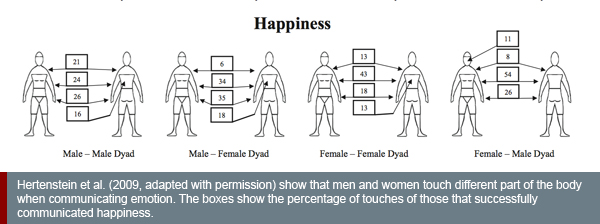Sex & Gender Analysis
Case Studies
- Science
- Health & Medicine
- Chronic Pain
- Colorectal Cancer
- Covid-19
- De-Gendering the Knee
- Dietary Assessment Method
- Gendered-Related Variables
- Heart Disease in Diverse Populations
- Medical Technology
- Nanomedicine
- Nanotechnology-Based Screening for HPV
- Nutrigenomics
- Osteoporosis Research in Men
- Prescription Drugs
- Systems Biology
- Engineering
- Assistive Technologies for the Elderly
- Domestic Robots
- Extended Virtual Reality
- Facial Recognition
- Gendering Social Robots
- Haptic Technology
- HIV Microbicides
- Inclusive Crash Test Dummies
- Human Thorax Model
- Machine Learning
- Machine Translation
- Making Machines Talk
- Video Games
- Virtual Assistants and Chatbots
- Environment
Haptic Technology: Analyzing Gender - Purpose of Touch
Purpose of Touch
Touches can be accidental, instrumental (for example, in nursing), affectionate (showing support), controlling, ritualistic (for example, in a handshake), playful, etc. The appropriateness of the touch depends on who is touching, in what social context (public or private, for example), and for what purpose.
In a study analyzing whether touch can convey distinct emotions, researchers found that gender matters. The figure below shows when seeking to communicate emotion, men and women typically touch different body parts. For happiness, men touch men on the shoulder more often, while men tend to touch women on the arm. The left figure in each pair represents the front of the body and the right the back of the body. Women often touch women on the shoulder, and women allow themselves to touch men’s faces, but most often touch the upper arm (Hertenstein et al., 2009).

A different study showed that the same touch for different purposes can also elicit different responses. In a controlled experiment, researchers found that when participants were told they were being touched for medical purposes, such as to have their pulse taken, their blood pressure and heart rate decreased. An unexplained touch, however, to the same part of the arm elicited an increase in cardiovascular response. The change in heart rate also depended on the gender of the toucher and the touched. Female experimenters (those administering the touch) elicited greater decreases in heart rate than male experimenters, while in the second condition, male experimenters touching female participants caused the largest increases in pulse (Nilsen & Vrana, 1998).
Effective haptic technologies will be especially important for caring tasks, such as nursing (van Erp & Toet, 2013, 2015). Patient reaction to nurses’ touch differed according to purpose, such as instrumental (e.g., bathing), expressive (e.g., comforting), or protective (e.g., a nurse moving a patient’s hand away from ventilator tubing). The interaction between the nurses’ and patents’ gender has been extensively analyzed, especially surrounding the issues of male nurses’ touch, which some fear will be misinterpreted by both men and women patients (O’Lynn and Krautscheid, 2011).





